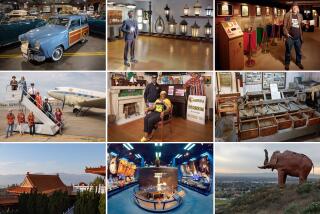Cultural gems in war’s cross hairs
- Share via
IT occurred to me recently that many of the tourist sights I hold most dear -- France’s Normandy battlefield, Pennsylvania’s Gettysburg and England’s Coventry Cathedral -- have to do with war. The realization came as no coincidence, because I had been reading “The Destruction of Memory: Architecture at War,” a new book by Australian Robert Bevan, about what is lost, beyond human lives, when people go to war.
The book is a distressingly long catalog of culturally significant places destroyed by conflict. After assessing how and why such instances of vandalism occur, Bevan concludes that buildings and monuments are often attacked, “not because they are in the path of a military objective: to their destroyers they are the objective.”
This is especially true, Bevan says, in cases of genocide and ethnic cleansing, when architecture is targeted to demoralize the enemy and ultimately to erase a people’s heritage from the face of the Earth.
During the horrendously destructive war in the former Yugoslavia, wrenched apart after the fall of the Soviet Union, at least 100,000 people were killed and more than 3,000 sites were obliterated. These included places in Bosnia and Herzegovina -- the main mosque in Sarajevo and a graceful bridge over the Neretva River in Mostar. Bevan says Croats targeted the landmark 16th century Ottoman bridge because it symbolized ethnic homogeneity in a cosmopolitan city that had the highest rate of mixed marriages in the region. The bridge, rebuilt in 2004, seems to the author to be more an emblem of hope than a reflection of achieved peace, because Mostar remains a city divided between Catholics and Muslims.
Religious sites are inevitable targets in armed conflict, and their loss is most keenly felt by the people who worshiped there, of course. But synagogues, temples, mosques and churches are also rich artistic repositories, which is why their destruction leaves blank pages in the cultural history of humankind. For the curious traveler, that means the world is shrinking as war wipes out sights worth seeing and understanding.
Every two years, the New York-based World Monuments Fund releases a list of the 100 most endangered sites and cultural treasures in the world. In its last list, published in June, the organization cited the whole of Iraq, where ongoing conflict has taken a toll on such sites as the ancient Assyrian capital of Nineveh and, last month, Samarra’s Golden Mosque.
“These sites are most endangered because they’re in the midst of very complex situations created by conflict,” said Bonnie Burnham, president of the World Monuments Fund. “Looting takes place. Monuments are targeted for destruction as symbolic gestures against another culture’s values. A government’s capacity to address the situation is undermined because humanitarian and security issues must take top priority.”
How nations and cultural organizations address the physical casualties of war varies. Sometimes, lost sites are painstakingly rebuilt, as in Mostar. But in many instances, reconstructions like that of the domed, early 19th century Church of St. Alexander in Warsaw after World War II, lack the detail, workmanship and deep meaning of the originals, architecture critics say.
In other cases, the rebuilding is so thorough that nothing remains to tell the story of what was lost, as at St. Malo on the Brittany coast of France, where visitors can walk the massive medieval walls unaware that 80% of the city was destroyed by shelling during World War II.
There is a danger in re-creating lost sites as they were before war because their defacement or destruction is part of their history and meaning.
In many cases, rubble serves better than re-creations to remind travelers about the devastating futility of war. The central French village of Oradour-sur-Glanes, razed by retreating German forces on June 10, 1944, after the massacre of 642 civilians there, has been left in ruins. When I visited last year, I found the ruins far more haunting than any monument or reconstruction.
In the English Midlands city of Coventry, where German aerial bombing ignited a ravaging firestorm in 1940, a new cathedral has risen. It is not a re-creation of the soaring medieval original but a strikingly modern structure. Tellingly, it sits beside the shell of the destroyed church, left as a reminder.
Coventry Cathedral was not a victim of collateral damage in the 20th century’s most destructive war. The Germans targeted it in what came to be known as the Baedeker raids aimed at demoralizing the enemy by destroying treasured sites in England. The British and their allies retaliated, dumping bombs on such German cultural icons as the Berlin State Opera House, and the Baroque city of Dresden.
Today, specific targeting continues as such organizations as Al Qaeda have taken aim at landmarks, which in the minds of Muslim terrorists stand as symbols of Western secularism, greed and evil. They tragically hit their mark in New York City and at the Pentagon, but, as Bevan reports, many other potential targets were considered, including the Eiffel Tower, the Vatican, and L.A.’s Library Tower (now the U.S. Bank Tower).
Rome without St. Peter’s seems inconceivable, but so too did New York without the World Trade Center towers to many of us before Sept. 11, 2001. The empty space in downtown Manhattan has become a tourist attraction, like all too many scenes of violence and destruction around the world.
To my mind, visiting them is more than just sightseeing. It gives travelers a chance to honor the dead, better understand war’s complex causes and hope for peace again and always.
*
Susan Spano also writes “Postcards From Paris,” which can be read at latimes.com/susanspano.
More to Read
The biggest entertainment stories
Get our big stories about Hollywood, film, television, music, arts, culture and more right in your inbox as soon as they publish.
You may occasionally receive promotional content from the Los Angeles Times.










